 |
 |
Furious Class and Spectre Class
![]() Diagrams
Diagrams![]()
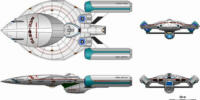 Furious class orthographic views |
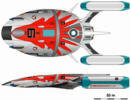 Spectre class orthographic views |
 Furious deck plans, part 1 created by Allen Rolfes (see notes) |
 Furious deck plans, part 2 created by Allen Rolfes (see notes) |
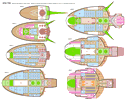 Spectre deck plans, part 1 created by Allen Rolfes (see notes) |
 Spectre deck plans, part 2 created by Allen Rolfes (see notes) |
 Spectre bluescale plans, part 1 created by Allen Rolfes (see legend) |
 Spectre bluescale plans, part 2 created by Allen Rolfes (see legend) |
 Spectre bluescale plans, part 3 created by Allen Rolfes (see legend) |
![]() Scenes
Scenes![]()
 Spectre class 3D model created by The Chief |
 Spectre in orbit model by Terradyhne, rendered by cmdr_kobosh |
 Spectre in orbit model by Terradyhne, rendered by cmdr_kobosh |
 Spectres in orbit model by Terradyhne, rendered by cmdr_kobosh |
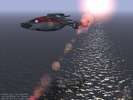 Spectre scene model by Terradyhne, rendered by cmdr_kobosh |
![]() History
History![]()
Starfleet Museum
Report: FURIOUS-class cruiser and SPECTRE-class destroyer
This report from the Starfleet Museum includes
historical documents and my own comments concerning the
development of two related ship classes from the 2290's: the
FURIOUS-class cruiser and the SPECTRE-class destroyer.
Starfleet Office of
Public Information. Media Release. October 15, 2296
The USS FURIOUS is the new deep-reaction penetrator for
theStarfleet frontier defense forces. In the event of a fleet
scale, hostile-force incursion, ships of the FURIOUS class would
take the fight to the enemy by interrupting invasion supply
routes and pre-emptively counterstriking follow-up invasion
forces behind the enemy's front lines.
Since FURIOUS was not intended for long-duration exploratory missions, most equipment and accommodations for research specialists have been eliminated. This has allowed the use of a smaller-diameter, lower-weight modification of the standard class 1b command hull. With powerful FGD-135 warp drive nacelles and low displacement, USS FURIOUS is considerably faster and more maneuverable than most other Starfleet cruisers. The mounting of two independent impulse drive units allows unmatched sublight agility, reliability, and fighting ability.
FURIOUS is equipped with unprecedented defensive striking power in a ship of its size. Mounted in a special convertible tactical superhull atop the primary hull are four megaphaser cannons and four photon torpedo tubes. Mounted in the bow is a new, ultrahigh-sensitivity, passive and active, acquisition and targeting-dedicated sensor array. Carried on board are transatmospheric area-superiority and attack fighters, drones, and "brilliant" M/AM munitions for orbital bombardment. Generous facilities have been dedicated to Marine barracks, armories, workshops, sickbays, training and acclimatization simulators, and preinsertion preparation areas. A full battalion of 100 power-suited Marines, together with their light armor and support personnel, can be accommodated.
The FURIOUS class is currently in production at Supra Yokohama (Earth, Sol III) and Utopia Planitia (Mars, Sol IV), Starfleet Yards. Because of these ships' extreme importance to Federation security, their exact specifications and capabilities are still classified. Seven ships have entered service with Starfleet Frontier Defense along the Klingon and Romulan treaty borders. An additional 19 ships will enter service through FY 2301.
Masanori
Wellington-Sosa. "Furious: The Wrong Ship at the Wrong
Time." Tactical Review, January 9, 2297
The new FURIOUS-class cruiser is described by the
Starfleet Office of Public Information as a "deep-reaction
penetrator" that is to play a vital part in Starfleet's new
doctrine of Deep-Reactive Defense. According to this doctrine, in
the event of an invasion by Romulan, Klingon, or other hostile
forces, Starfleet Strike Squadrons would penetrate deep behind
enemy lines and attack logistic convoys and second-wave
invasion-fleet concentrations rather than mounting a defense only
within Federation space.
Unfortunately, this supposed doctrine is pure fiction intended to conceal the true mission of the FURIOUS class. Through its extensive system of starbases and the time-tested doctrine of defense in depth, Starfleet is already more than capable of protecting our frontiers against any foreseeable threat. There is no need to resort to such a belligerent "defensive" posture. Under the cloak of Federation security, the FURIOUS class is being equipped with capabilities that can in no way be considered defensive.
In fact, the FURIOUS class is intended to provide the deep offensive strike capability that expansionist elements in Starfleet have coveted for many years. Equipped with overwhelming firepower, active and passive sensor countermeasures, warp-signature damping, and extreme speed, the FURIOUS-class is designed to penetrate heavily defended enemy frontiers in independent raids or to prepare pathways for large fleet advances. Able to carry a full company of 150 power-suited Marines and armed with extraordinary firepower, ships of this class will be able to strike deep within hostile space to seize, hold, destroy, or retrieve vital assets, and, possibly, to directly threaten the homeworlds of any foreseeable rival.
FURIOUS marks the introduction of a new class of extremely powerful warships. Aside from any defensive or deterrent value it might have, the FURIOUS class provides Starfleet with a startling new offensive capability that, given the present political climate of rapproachment with the Klingon Empire, is reckless and ill-considered. In this regard, FURIOUS is clearly the wrong ship at the wrong time. Already, nine ships are believed to have entered service, including four unacknowledged ships that have reportedly joined the "Black Fleet" of Starfleet Intelligence. Should the projected 26 starships of this unnecessary class be built, a potential ally may forced to reconsider its position. If these warships must be built, they should, at the very least, be based deep within Federation space and away from any potential mischief. The stationing of such clearly offensive ships along our frontier would be a blatantly provocative and aggressive gesture. With a peaceful resolution to 75 years of bitter conflict so close at hand, it is time for Starfleet to step away from the brink. (Mr. Wellington-Sosa is a civilian analyst with the BLAND Corporation, an independent center for defense technology assessment and policy analysis based in New York City, Earth.)



Commodore Ekaterina
Tsieng (ret.). "FURIOUS: The Last, Best Hope for Peace
(letter)." Tactical Review, January 23, 2297
I am sure that I speak for many of my fellow Starfleet officers,
both active and retired, when I say that I am proud that the
Federation has finally showed signs of abandoning the cowardly
and defeatist policy of "Defense in Depth." This
doctrine of so-called "defense" requires that worlds on
the forward frontiers of our space be sacrificed to the
predations of alien aggressor species for the benefit of
supposedly more vital core systems. I am certain that the brave
men and women who have toiled for decades under brutal conditions
to make these previously hostile worlds into gardens of human
civilization do not appreciate the fact that Starfleet Command
considers their homes expendable. Were the Klingon Empire to
invade Federation space, who would inform these valiant pioneers
that their homes must be evacuated, then laid waste in combat in
order to ensure the safety of effete defense "experts"
on Zakdorn and Terra?
Instead of meekly reacting to invasion by passively surrendering sectors of space until stronger units arrive from light years away, we should instead deter invasion by showing our determination to defend every cubic meter of Federation space. To this end, Starfleet should deploy its most capable warships, including the ships of the vitally needed FURIOUS class, along border areas rather than hide them safely away in secure core systems. Furthermore, we should clearly signal our readiness and ability to use early defensive counterforce actions, or even pre-emptive actions, to repel or prevent any invasion of our space.
Evidently, Mr. Wellington-Sosa and others of his spineless ilk are too timid to risk upsetting the frail and sensitive Klingon by confronting him with forces of credible strength. In fact, all the Klingon has ever and will ever understand is brute force. To leave our borders naked and open to predation all but invites the Klingon to use his still formidable forces to penetrate Federation space and stand upon our worlds with his clawed boots. We should send a strong and unambiguous message to the Klingon that any aggression will be met with overwhelming fury and punished with righteous vengeance from the outset. The new FURIOUS class will give Starfleet the means to uphold our sworn duty to defend the lives of Federation citizens from this alien pestilence. Should the Klingon snake choose to strike, FURIOUS and her mighty sisters would quickly cut off its head then seek out and exterminate the serpent's nest.
Do not be fooled by the Klingon's professed wishes for peace. He has always coveted our worlds and covets them still, despite his present difficulties (the true severity of which many of us doubt). Rather than appeasing the Klingon by offering our frontier worlds as new jewels for his imperial crown, we should strive to use any means at our disposal to eradicate forever this malignant threat to galactic peace.


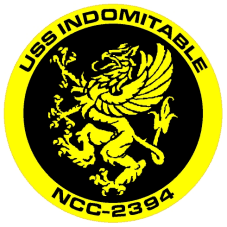
Historical Commentary
Unknown to civilian defense analysts and to most Starfleet
personnel below the highest levels of Starfleet Command in 2297
was that a primary mission of the FURIOUS-class cruiser was to
divert attention from the SPECTRE-class destroyer, which was
secretly developed and exclusively operated by Starfleet
Intelligence. The Starfleet Office of Public Information, which
was probably unaware of SPECTRE's existence, had been given data
to disseminate that emphasized and exaggerated FURIOUS's
offensive capabilities. This misinformation was designed to make
FURIOUS an issue of public controversy so that the SPECTRE class
would not be. In addition, Commodore Tsieng (who was suspected,
but never proven, to have had prior knowledge of the 2293
Chancellor Gorkon assassination plot) and other retired Starfleet
officers with links to Intelligence increased the intensity of
the controversy by publicly and vehemently championing the
FURIOUS class and denouncing any moves towards detente between
the Federation and the Klingon Empire. (I should note that
although Commodore Tsieng's rabid rhetorical style may now appear
ridiculously overblown [which may have been the intended effect],
similar unapologetically racist opinions were still voiced openly
throughout the Federation and Starfleet, particularly by humans,
well into the 24th century).
All these efforts of concealment seem to have been effective, as the existence of the SPECTRE class was not revealed to Federation citizens until 2337, by which time all ships had been withdrawn from service. In fact, the first public reports of the SPECTRE class actually reached the Federation from sources within the Klingon Empire, which had encountered SPECTRE-class ships soon after their introduction in 2296. However, Starfleet Command and Starfleet Intelligence refused to either confirm or deny the existence of this class until 2351.
The SPECTRE class had originated in 2289 as a secret design study by Starfleet Intelligence for a ship capable of delivering and retrieving personnel and equipment from enemy-controlled space. This study, code-named "Havoc," was for a small ship (50,000 tons) with a crew (excluding Marines) of about 30. At the same time, Starfleet Tactical had recognized a need for a battle cruiser that could spearhead advances across heavily defended frontiers. This led to another independent design study, code-named "Archer," for a heavily armed "penetration cruiser" weighing some 150,000 tons.
However, neither project advanced further than the preliminary design stage until the Gorkon Crisis of 2293. Captain James T Kirk and Dr. Leonard H McCoy of USS ENTERPRISE (NCC-1701A) were arrested and put on trial on Qo'noS, the Klingon homeworld, for the Klingon Chancellor's murder. Although Starfleet Tactical Command had planned a rescue mission code named "Operation Retrieve," there was little chance of such a plan succeeding. Then as now, Qo'noS, unlike Earth, is defended by a squadron of home-guard cruisers and armored battlestations out to a distance of some 5 light years. Furthermore, Qo'noS lies more than 50 light years from the border with the Federation. The likelihood of a handful of EXCELSIOR-class and upgraded ENTERPRISE-class cruisers reaching Qo'noS, much less extracting anyone from Klingon custody, approaches zero. Had the mission been attempted, all ships involved would likely have been destroyed, Kirk and McCoy would have remained in Klingon custody and been immediately executed, and the Federation (or possibly Earth alone) would have been at war with the Klingon Empire.
Although the crisis was resolved peacefully, both Starfleet Tactical Command and Starfleet Intelligence were extremely frustrated by their inability to launch a credible rescue mission. Accordingly, both services examined their respective design studies and adapted them for use in such a mission in predictable ways: Starfleet Tactical tends to respond to any difficult situation with higher speeds and greater firepower, whereas Starfleet Intelligence attempts to use greater secrecy and stealth. "Archer" basically became a cut-down ENTERPRISE class cruiser with more powerful weapons and propulsion, whereas "Havoc" evolved into a more radical design requiring more advanced, as-yet-undeveloped technologies.
Unfortunately, the introduction of a new class of ships based on either design study was certain to be controversial given the recent successful conclusion of the galactic peace conference at Camp Khitomer. Although rapprochement with the Klingons was still strenuously opposed by many Starfleet officers, the desire for peace by the Federation was, for the most part, genuine and widespread. Therefore, obtaining funding through the Federation Council for production of ships based on either "Havoc" or "Archer" would be difficult. Another obstacle was that "Archer" had been championed by Admiral Lemuel Cartwright, a co-conspirator in the plot to assassinate the Klingon Chancellor and the Federation President. For these reasons, Starfleet Tactical considered the "Archer" project effectively dead. Although Starfleet Intelligence had control over a publicly unacknowledged "black budget" to secretly finance the production and operation of its own ships, sufficient funds to build "Havoc" were unavailable to be diverted from other projects and missions.
Despite these obstacles, Starfleet Intelligence was determined to build this new ship class and was willing to go to extreme lengths to do so. Although Intelligence normally operates in a state of nearly paranoid secrecy, in January 2294 Admiral Iqbal Gyandzha, Director of Starfleet Intelligence, took the unprecedented step of inviting Admiral Marcellus Vo, Chief of Starfleet Tactical, to a meeting in the Pakoreh Nebula, where he proposed a way of producing both their ships. At first, Admiral Vo was, to put it mildly, unpleasantly surprised that Starfleet Intelligence was even aware of "Archer." Evidently, not even the highest levels of Starfleet Command were immune to Intelligence surveillance. Since any attempt to increase funding for Intelligence would be likely to arouse suspicion, Admiral Gyandzha proposed that "Archer," the less controversial project, would be built with public funds, which could be obtained from the Federation Council with the help of Starfleet Intelligence. Some of these funds would be secretly diverted to help finance the building of "Havoc." In this way, "Archer" could serve as a lightning rod for public criticism so that the development of "Havoc" would remain secret and protected. In addition, technological advances from the development of "Havoc," particularly in weapons, propulsion, materials, stealthing, and countermeasures, could be applied to "Archer." Although Admiral Vo was justifiably suspicious about intelligence agents bearing gifts, he put aside his wariness and agreed to the plan.
Admiral Gyandzha next approached the Braxton/Callisto Corporation to propose that a new class of ships based on "Havoc" be built by its famous Advanced Projects Development Division, better know as the Weasel Works. The Weasel Works had a well-deserved reputation for producing extreme technology under conditions of utmost secrecy. They had been responsible for the introduction of the first-generation photon torpedo in 2215 and for numerous weapons systems designed to fight the Borg in the 2370's. Admiral Gyandzha made assurances that if Braxton/Callisto could agree to deliver a ship based on "Havoc" within 18 months, they would also receive the contract to build the as-yet-announced class of ships to be based on "Archer."
In June 2294, a budget request was made to the Federation Council to fund the development of a new battle cruiser class. Although some council members had publicly questioned the need for this new class, opposition soon faded when Starfleet Intelligence held "candid and confidential meetings" with these members. As promised, Braxton/Callisto was selected as the prime contractor. By August 2295, construction of the lead ship of the new FURIOUS class (NCC-2370) was underway at the Supra-Yokohama and Utopia Planitia Starfleet Yards. Meanwhile, at Braxton/Callisto's Weasel Works division, which had recently relocated to a hollowed-out asteroid in the Eltanin system, development continued on "Havoc."
USS FURIOUS joined the fleet in October 2296. As had been intended, FURIOUS was rather conventional in its technology, if not its layout. Most of its components, including the primary hull, bridge module, shuttlecraft bay, impulse engines, warp core, hull phasers, and the command and control system were derived from the ENTERPRISE class. The primary hull was narrowed and topped with a large faired weapons housing containing four photon torpedo tubes and four megaphaser cannons. The small secondary hull contained the matter/antimatter (M/AM) reactor, AM storage, the shuttlecraft bay, and rearward torpedo tubes. New linear FGD-135 linear warp drive nacelles were developed in house at Braxton/Callisto for use in both the FURIOUS and SPECTRE classes.
FURIOUS's capabilities and weaponry were almost certainly exaggerated by contemporary disinformation to make it appear more threatening and to facilitate confusion with the secret, unacknowledged SPECTRE class. All measures of performance seem to have been exaggerated by at least 20%. FURIOUS could carry fewer marines and fighter craft than publicly stated and had no cloaking device but did have a limited sensor ghosting capability.
Despite its somewhat nonsensical designation as a "deep reaction penetrator," FURIOUS was a very capable medium cruiser which performed well in traditional roles. When introduced, FURIOUS had firepower exceeding that of the ENTERPRISE and EXCELSIOR classes. Tactical systems advances included a new rotary photon torpedo launch system, more powerful megaphaser cannons, and improved deflector shielding, which were also applied to the SPECTRE class. FURIOUS was faster and more maneuverable at both impulse and warp speeds because of its lower weight and smaller size. However, its narrow focus on speed and weaponry over scientific facilities meant that FURIOUS-class ships rarely strayed far from designated stations except for training and during times of crisis. FURIOUS-class ships were usually based at remote border areas along with Starfleet Intelligence's SPECTRE-class ships.
Because of the self-imposed isolation of the Romulans after the Tomed Incident (2311) and the warming relations with the Klingons, FURIOUS-class ships saw few major actions and were never used in their intended role of "deep-reactive penetrator" against either of these powers. However, FURIOUS-class ships remained in service until 2351 and were involved in numerous smaller actions in which they acquitted itself well. In October 2307, Ambassador Constanza Lowell and her embassy staff were taken hostage during the attempted coup d'etat on Jacarrh II, which was not yet a Federation member. Ships participating in the successful rescue included three FURIOUS-class ships under the command of Admiral Petra Gernreich: USS MAJESTIC (NCC-2380), USS SPLENDID (NCC-2391), and USS HORRIBLE (NCC-2372), which is now on display at the Starfleet Museum. In 2327, USS AUDACIOUS (NCC-2378), USS SWIFTSURE (NCC-2381), and possibly USS INDOMITABLE (NCC-2394) were involved in a still-classified action along the frontier with the Cardassian Union.

created by The Chief
Three quarters of a century after the SPECTRE class entered service, much about these ships remains classified. For reasons of "Federation security," SPECTRE's exact service displacement, weaponry, internal arrangement, complement, performance, and operational history have never been revealed. The example in the Starfleet Museum collection, the only example ever publicly displayed, was obtained directly from Starfleet Command in 2355. Although hull markings identify this ship as "USS BANSHEE" (hull number 6), we cannot confirm whether this is her true designation. Nearly all equipment, including the impulse reactors, warp powerplant, warp nacelles and weaponry, had been removed before delivery to the museum.
However, from what we have learned from declassified Starfleet files and from information, including sensor data and visual records, from private and industry sources, we have been able to piece together a profile of this class. SPECTRE appears to have entered service with the "Black Fleet" of Starfleet Intelligence in early 2296. Eventually 15 to 20 ships were built and remained in service until at least 2330. Complete ship names are unknown, but did include SPECTRE, BANSHEE, YUREI, EIDOLON, WRAITH, PHANTOM, SHADOW, DUKHI, SPIRIT, UMBRA, and MRAKZHIL.

SPECTRE was 143 m long, and our analysis of the materials and structure suggests a displacement of approximately 85,000 tons. The layout of the SPECTRE class was highly unusual for its time. Rather than the flat disc of the 1b starship primary hull, SPECTRE had a dorsally streamlined, blunt arrowhead-shaped primary hull. The bridge module was buried deep within rather than atop the primary hull. Five spines of unknown function projected from the rear crest of the primary hull. The secondary hull was extremely small and housed only the warp power assembly (M/AM reactor, AM containment bottles, warp plasma conduits, nacelle supports) and twin rearward-firing photon torpedo tubes. A shuttlecraft dropbay was located in the ventral primary hull, immediately in front its junction with the secondary hull.
SPECTRE was powered by a specially modified, high-capacity M/AM reactor, designated SSWR-15-D4, which had originally been developed for use in the 170,000-ton PANTHER class of 2295, also built by Braxton/Callisto. The warp nacelles were scaled-down versions of the FGD-135 units of the FURIOUS-class which had been modified to muffle the warp signature. The nacelles each weighed approximately 20,000 t and together accounted for nearly 50% of the ship's total displacement. Recent performance simulations suggest that the maximum speed of SPECTRE exceeded the Warp 12 (old scale) of the ENTERPRISE and BELKNAP cruisers. However, because of the relatively small amounts of fuel carried by SPECTRE, this maximum speed could probably not have been sustained for more than a few hours. Impulse power was provided by twin spherical fusion reactors, again originally developed for use in the PANTHER class.
SPECTRE was extremely heavily armed for a ship of its size. The improved megaphaser cannons and photon torpedo launch system were similar to those used in the FURIOUS class. However, because of space limitations the number of photon torpedoes was likely about 48, half the number carried by the FURIOUS and ENTERPRISE classes. Some ships may have mounted an as-yet unidentified "super weapon" in a blister at the front of the primary hull. In addition, facilities were available for a platoon of 40 power-suited Marines, who could land on planetary surfaces with transporters or assault shuttles or could enter ships or space stations with specialized grapples and hull bores.
SPECTRE also carried an outstanding sensor-countermeasures array. This is believed to have included a cloaking device, the ability to clear a sensor-blind corridor several hundred kilometers wide along which others ships could follow undetected, and a "ghost" capability that allowed multiple false sensor images to be projected a distance of several hundred thousand kilometers. For intelligence gathering, SPECTRE carried a wide array of active and passive onboard sensors as well as facilities for releasing sensor probes and servicing sensor buoys.
Although the service records of the SPECTRE-class ships remain classified, it is possible to speculate on the types of missions they may have carried out. Warp signatures not matching those of any known Federation vessel suggest that SPECTRE-class ships were involved in numerous intelligence raids, surveillance missions, and defections across the Klingon, Romulan, and Tholian borders until its retirement in the mid-2320's. The aforementioned embassy rescue on Jacarrh II in 2307 probably involved at least two SPECTRE-class ships in addition to the publicly acknowledged FURIOUS-class ships. Recent scholarship has even suggested that the Tomed Incident of 2311, which led to the Treaty of Algeron prohibiting the Federation's use of cloaking technology, may have been precipitated by the actions of one or more SPECTRE-class ships.
![]() Commissioned Furious-Class Ships
Commissioned Furious-Class Ships![]()
| FURIOUS GLORIOUS HORRIBLE MERCILESS RELENTLESS TERRIBLE SAVAGE SPITEFUL AUDACIOUS DAUNTLESS MAJESTIC SWIFTSURE SUPERB |
NCC-2370 NCC-2371 NCC-2372 NCC-2373 NCC-2374 NCC-2375 NCC-2376 NCC-2377 NCC-2378 NCC-2379 NCC-2380 NCC-2381 NCC-2382 |
PEERLESS COURAGEOUS INVINCIBLE INFLEXIBLE BRILLIANT TRIUMPHANT VIGILANT RESOLUTE SPLENDID VENGEFUL FORMIDABLE INDOMITABLE TENACIOUS |
NCC-2383 NCC-2384 NCC-2385 NCC-2386 NCC-2387 NCC-2388 NCC-2389 NCC-2390 NCC-2391 NCC-2392 NCC-2393 NCC-2394 NCC-2395 |
![]() Furious-Class
Specifications
Furious-Class
Specifications![]()
Standard displacement: 158,720 t
| Overall | 1° Hull | 2° Hull | Nacelles | |
| Length [m] | 246.09 | 171.35 | 69.63 | 84.49 |
| Beam [m] | 111.16 | 111.16 | 20.54 | 12.17 |
| Draft [m] | 37.41 | 27.10 | 26.91 | 21.17 |
Complement: 339 (40 officers, 219 crew, 80 Marines)
Weapons: 12
phaser turrets in twin mounts, 6 photon torpedo tubes (4 fore, 2
aft) with 96 torpedoes, 4 megaphaser cannons
Embarked craft: 2 personnel shuttlecraft, 4 assault shuttlecraft, 4
fighters
Velocity: Warp
9.5, standard (old scale); Warp 12, maximum
![]() Spectre-Class
Specifications*
Spectre-Class
Specifications*![]()
Standard displacement: 85,000 t
| Overall | 1° Hull | 2° Hull | Nacelles | |
| Length [m] | 186.91 | 121.80 | 66.23 | 69.73 |
| Beam [m] | 91.32 | 69.09 | 21.60 | 13.09 |
| Draft [m] | 21.94 | 19.30 | 14.97 | 18.50 |
Complement: 150 (15
officers, 95 crew, 40 Marines)
Weapons: 10 phaser turrets in twin mounts, 4
photon torpedo tubes (2 fore, 2 aft) with 48 torpedoes, 2
megaphaser cannons
Embarked craft: 2 personnel shuttlecraft, 2
assault shuttlecraft
Velocity: Warp 10, standard (old scale); Warp
12.5, maximum
*All figures are estimates.
![]()